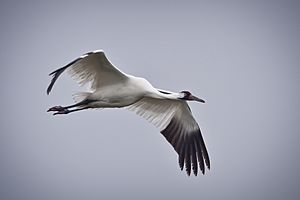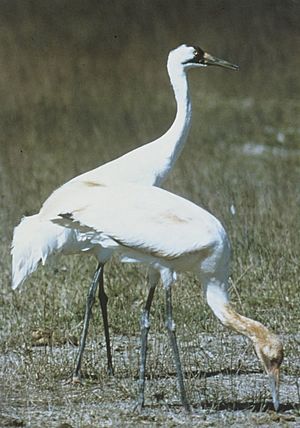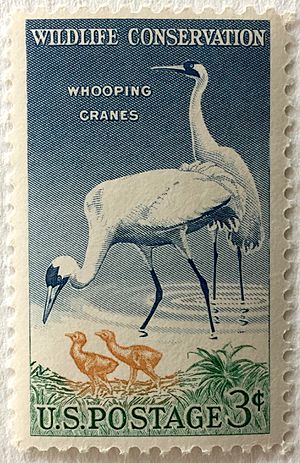Whooping crane facts for kids
Quick facts for kids Whooping crane |
|
|---|---|
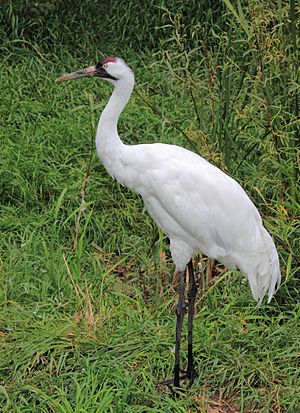 |
|
| In the Calgary Zoo, Alberta | |
| Conservation status | |
| Scientific classification | |
| Genus: |
Grus
|
| Species: |
americana
|
 |
|
| Distribution map of the whooping crane. blue: breeding, orange: wintering, green: year-round, grey: experimental year-round | |
| Synonyms | |
|
Ardea americana Linnaeus, 1758 |
|
The whooping crane (Grus americana) is an endangered crane species, native to North America, named for its “whooping” calls. Along with the sandhill crane (Antigone canadensis), it is one of only two crane species native to North America, and it is also the tallest North American bird species. The whooping crane's lifespan is estimated to be 22-24 years in the wild. After being pushed to the brink of extinction, due to unregulated hunting and loss of habitat, and just 21 wild (and two captive) cranes remaining by 1941, conservation efforts would lead to a partial recovery. The total number of cranes in the surviving migratory population, plus three reintroduced flocks and in-captivity, only slightly exceeds 800 birds as of 2020[update].
Contents
Description
An adult whooping crane is white with a red crown and a long, dark, pointed bill. However, immature whooping cranes are cinnamon brown. While in flight, their long necks are kept straight and their long dark legs trail behind. Adult whooping cranes' black wing tips are visible during flight.
On average, the whooping crane is the fifth-largest extant species of crane in the world. Whooping cranes are the tallest bird native to North America and are anywhere from the third to the fifth heaviest species on the continent, depending on which figures are used. The species can reportedly stand anywhere from 1.24 to 1.6 m (4 ft 1 in to 5 ft 3 in) in height. Wingspan, at least typically, is from 2 to 2.3 m (6 ft 7 in to 7 ft 7 in). Widely reported averages put males at a mean mass of 7.3 kg (16 lb), while females weigh 6.2 kg (14 lb) on average (Erickson, 1976). However, one small sample of unsexed whooping cranes weighed 5.82 kg (12.8 lb) on average. Typical weights of adults seem to be between 4.5 and 8.5 kg (9.9 and 18.7 lb). The body length, from the tip of the bill to the end of the tail, averages about 132 cm (4 ft 4 in). The standard linear measurements of the whooping cranes are a wing chord length of 53–63 cm (21–25 in), an exposed culmen length of 11.7–16 cm (4.6–6.3 in) and a tarsus of 26–31 cm (10–12 in). The only other very large, long-legged white birds in North America are: the great egret, which is over a foot (30 cm) shorter and one-seventh the weight of this crane; the great white heron, which is a morph of the great blue heron in Florida; and the wood stork. All three other birds are at least 30% smaller than the whooping crane. Herons and storks are also quite different in structure from the crane. Larger individuals (especially males of the larger races) of sandhill crane can overlap in size with adult whooping cranes but are obviously distinct at once for their gray rather than white color.
Their calls are loud and can carry several kilometers. They express "guard calls", apparently to warn their partner about any potential danger. A crane pair jointly calls rhythmically ("unison call") after waking in the early morning, after courtship, and when defending their territory. The first unison call ever recorded in the wild was taken in the whooping cranes' wintering area of the Aransas National Wildlife Refuge during December 1999.
Distribution and habitat
At one time, the range for the whooping crane extended throughout midwestern North America as well as southward to Mexico. By the mid-20th century, the muskeg of the taiga in Wood Buffalo National Park, Alberta and Northwest Territories, Canada, and the surrounding area had become the last remnant of the former nesting habitat of the Whooping Crane Summer Range. However, with the recent Whooping Crane Eastern Partnership Reintroduction Project, whooping cranes nested naturally for the first time in 100 years in the Necedah National Wildlife Refuge in central Wisconsin, United States, and these have subsequently expanded their summer range in Wisconsin and surrounding states, while reintroduced experimental non-migratory populations have nested in Florida and Louisiana.
Whooping cranes nest on the ground, usually on a raised area in a marsh. The female lays 1 or 2 eggs, usually in late-April to mid-May. The blotchy, olive-coloured eggs average 2½ inches in breadth and 4 inches in length (60 by 100 mm), and weigh about 6.7 ounces (190 g). The incubation period is 29–31 days. Both parents brood the young, although the female is more likely to directly tend to the young. Usually no more than one young bird survives in a season. The parents often feed the young for 6–8 months after birth and the terminus of the offspring-parent relationship occurs after about 1 year.
Breeding populations winter along the Gulf coast of Texas, United States, near Rockport on the Aransas National Wildlife Refuge and along Sunset Lake in Portland, Matagorda Island, Isla San Jose, and portions of the Lamar Peninsula and Welder Point, which is on the east side of San Antonio Bay.
The Salt Plains National Wildlife Refuge in Oklahoma is a major migratory stopover for the crane population, hosting over 75% of the species annually.
As many as nine whooping cranes were observed at various times on Granger Lake in Central Texas in the 2011/2012 winter season. Drought conditions in 2011 exposed much of the lake bed, creating ample feeding grounds for these cranes just as they were taking their autumn migration through Texas.
Predators
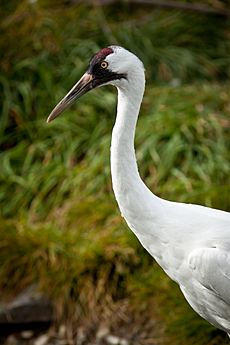
Their many potential nest and brood predators include the American black bear, wolverine, gray wolf, cougar, red fox, Canada lynx, bald eagle, and common raven. Golden eagles have killed some young whooping cranes and fledglings. Due to their large size, adult birds in the wild have few predators. However, American alligators have taken a few whooping cranes in Florida, and the bobcat has killed many captive-raised whooping cranes in Florida and Texas. In Florida, bobcats have caused the great majority of natural mortalities among whooping cranes, including several ambushed adults and the first chick documented to be born in the wild in 60 years. Adult cranes can usually deter or avoid attacks by medium-sized predators such as coyotes when aware of a predator's presence, but the captive-raised cranes haven't learned to roost in deep water, which makes them vulnerable to ambush. As they are less experienced, juvenile cranes may be notably more vulnerable to ambushes by bobcats. Patuxent Wildlife Research Center scientists believe that this is due to an overpopulation of bobcats caused by the absence or decrease in larger predators (the endangered Florida panther and the extirpated red wolf) that formerly preyed on bobcats. At least 12 bobcats have been trapped and relocated in an attempt to save the cranes.
Diet
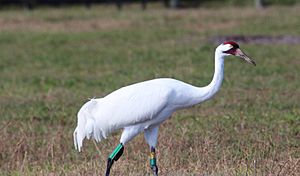
These birds forage while walking in shallow water or in fields, sometimes probing with their bills. They are omnivorous but tend to be more inclined to animal material than most other cranes. Only the red-crowned crane may have a more carnivorous diet among living cranes. In their Texas wintering grounds, this species feeds on various crustaceans, mollusks, fish (such as eel), small reptiles and aquatic plants. Potential foods of breeding birds in summer include frogs, small rodents, small birds, fish, aquatic insects, crayfish, clams, snails, aquatic tubers, and berries. Six studies from 1946 to 2005 have reported that blue crabs (callinectes sapidus) are a significant food source for whooping cranes wintering at Aransas National Wildlife Refuge, constituting up to 90 percent of their energy intake in two winters; 1992–93 and 1993–94.
Waste grain, including wheat, barley, and corn, is an important food for migrating whooping cranes, but whooping cranes don't swallow gizzard stones and digest grains less efficiently than sandhill cranes.
Individual recognition, territorial and partnership fidelity
In earlier years, whooping crane chicks had been caught and banded (in the breeding areas of Wood Buffalo National Park), which has delivered valuable insight into individual life history and behaviour of the cranes. This technique, however, has been abandoned due to imminent danger for the cranes and the people performing the catching and banding activities.
By recording guard and unison calls followed by frequency analysis of the recording, a "voiceprint" of the individual crane (and of pairs) can be generated and compared over time. This technique was developed by B. Wessling and applied in the wintering refuge in Aransas and also partially in the breeding grounds in Canada over 5 years. It delivered interesting results, i.e. that besides a certain fraction of stable pairs with strong affinity to their territories, there is a big fraction of cranes who change partners and territories. Only one of the exciting results was to identify the "Lobstick" male when he still had his band; he later lost his band and was recognized by frequency analysis of his voice and then was confirmed to be over 26 years old and still productive.
Conservation efforts
Whooping cranes are believed to have been naturally rare, and major population declines caused by habitat destruction and overhunting led them to them become critically endangered. Even with hunting bans, illegal hunting has continued in spite of potential substantial financial penalties and possible prison time. The population went from an estimated 10,000+ birds before the settling of Europeans on the continent to 1,300-1,400 birds by 1870. By 1938 there were just 15 adults in a single migratory flock, plus about thirteen additional birds living in a non-migratory population in Louisiana, but the latter were scattered by a 1940 hurricane that killed half of them, while the survivors never again reproduced in the wild.
In the early 1960s, Robert Porter Allen, an ornithologist with the National Audubon Society, appeared as a guest challenger on the network television show To Tell The Truth, which gave the Conservation movement some opportunity to update the public on their efforts to save the whooping crane from extinction. His initial efforts focused on public education, particularly among farmers and hunters. Beginning in 1961, the Whooping Crane Conservation Association (WCCA), was established to improve the status of the whooping cranes. This non-profit organization functioned largely by influencing federal, state and provincial political decisions and educating the general public about the critical status of the bird. The whooping crane was declared endangered in 1967.
Allen had begun an effort at captive breeding with a female crane named 'Josephine', the sole survivor of the Louisiana population, injured and taken into captivity in 1940, and two successive injured birds from the migratory population, 'Pete' and 'Crip', at the Audubon Zoo and the Aransas refuge. Josephine and Crip produced the first whooping crane born in captivity in 1950, but this chick only lived four days, and though decades of further efforts produced more than 50 eggs before Josephine's death in 1965, only four chicks survived to adulthood and none of them bred. At the same time, the wild population was not thriving. In spite of the efforts of conservationists, hunting bans and educational programs, the aging wild population would gain only 10 birds in the first 25 years of monitoring, with entire years passing without a single new juvenile joining those that returned to the Texas wintering grounds. This led to a renewed tension between those who favored efforts to preserve the wild population and others seeing a captive breeding program as the only hope for whooping crane survival, even though it must depend on individuals withdrawn from the extremely-vulnerable wild population.
Identification of the location of the summer breeding grounds of the whooping cranes at Wood Buffalo National Park in 1954 allowed more detailed study of their reproductive habits in the wild, and led to the observation that while many breeding pairs laid two eggs, rearing efforts seemed to favor a single chick, and both chicks would almost never survive to fledge. It was concluded that the removal of a single egg from a two-egg clutch should still leave a single hatchling most likely to survive, while providing an individual for captive breeding. Such removals in alternating years showed no decline in the reproductive success of the wild cranes. The withdrawn eggs were transferred to the Patuxent Wildlife Research Center in Maryland, where approaches for hatching and rearing crane chicks in captivity had already been optimized using the more-numerous sandhill cranes. Initial challenges getting the resultant birds to reproduce, even using artificial insemination approaches, would give impetus to the first, unsuccessful attempt at reintroduction, by swapping whooping crane eggs into the nests of the more numerous sandhill cranes as a way to establish a backup population.
In 1976, with the wild population numbering only 60 birds and having increased at an average of only one bird per year over the past decades, ornithologist George W. Archibald, co-founder of the International Crane Foundation in Baraboo, Wisconsin, began working with 'Tex', a female whooping crane hatched at the San Antonio Zoo in 1967 to Crip and his new mate, the wild-captured 'Rosie', to get her to lay a fertile egg through artificial insemination. Archibald pioneered several techniques to rear cranes in captivity, including the use of crane costumes by human handlers. Archibald spent three years with Tex, acting as a male crane – walking, calling, dancing – to shift her into reproductive condition. As Archibald recounted the tale on The Tonight Show in 1982, he stunned the audience and host Johnny Carson with the sad end of the story – the death of Tex shortly after the hatching of her one and only chick, named 'Gee Whiz'. Gee Whiz was successfully raised and mated with female whooping cranes. The techniques pioneered at Patuxent, the International Crane Foundation and a program at the Calgary Zoo would give rise to a robust multi-institutional captive breeding program that would supply the cranes used in several additional captive breeding and reintroduction programs. A single male crane, 'Canus', rescued in 1964 as an injured wild chick and taken to Patuxent in 1966, would by the time of his 2003 death be the sire, grandsire or great-grandsire of 186 captive-bred whooping cranes. In 2017, the decision was made for the Patuxent Wildlife Research Center to end its 51-year effort to breed and train whooping cranes for release, due to changing priorities and in the face of budget cuts by the Trump administration. Their flock of 75 birds was moved in 2018 to join captive breeding programs at zoos or private foundations, including the Calgary Zoo, the International Crane Foundation, the Audubon Species Survival Center in Louisiana, and other sites in Florida, Nebraska, Oklahoma and Texas. This relocation is expected to negatively impact the reproductive success of the captive cranes, at least in the short term, and concerns were raised over its impact on the reintroduction efforts for which the Patuxent program had been providing birds.
Meanwhile, the wild crane population began a steady increase, such that in 2007 the Canadian Wildlife Service counted 266 birds at Wood Buffalo National Park, with 73 mating pairs that produced 80 chicks, 39 of which completed the fall migration, while a United States Fish and Wildlife Service count in early 2017 estimated that 505 whooping cranes, including 49 juveniles, had arrived at Aransas National Wildlife Refuge that season. As of 2020, there were an estimated 677 birds living in the wild, in the remnant original migratory population as well as three reintroduced populations, while 177 birds were at the time held in captivity at 17 institutions in Canada and the United States, putting the total population at over 800.
The wild cranes winter in marshy areas along the Gulf Coast in and surrounding the Aransas National Wildlife Refuge. An environmental group, The Aransas Project, has sued the Texas Commission on Environmental Quality (TCEQ), maintaining that the agency violated the Endangered Species Act by failing to ensure adequate water supplies for the birds' range. The group attributes the deaths of nearly two dozen whooping cranes in the winter of 2008 and 2009 to inadequate flows from the San Antonio and Guadalupe rivers. In March 2013 during continuing drought conditions, a federal court ordered TCEQ to develop a habitat protection plan for the crane and to cease issuing permits for waters from the San Antonio and Guadalupe rivers. A judge amended the ruling to allow TCEQ to continue issuing permits necessary to protect the public's health and safety. An appeals court eventually granted a stay in the order during the appeals process. The Guadalupe-Blanco and San Antonio river authorities joined TCEQ in the lawsuit, warning that restricting the use of their waters would have serious effects on the cities of New Braunfels and San Marcos as well as major industrial users along the coast. To address the potential of future crowding that may result from the increasing migratory population, in 2012 and following years, purchases of small plots of land and acquisition of conservation easements covering larger areas has led to the protection of tens of thousands of additional acres of potential coastal habitat near the Aransas reserve. A large purchase of over 17,000 acres in 2014 was paid for with $35 million made available from the settlement over the Deepwater Horizon oil spill and an additional $15 million raised by a Texas parks non-profit.
Concerns have been raised over the effects of climate change on the migratory cycle of the surviving wild population. The cranes arrive on their nesting grounds in April and May to breed and begin their nesting. When young whooping cranes are ready to leave the nest, they depart in September and follow the migratory trail through Texas.
Images for kids
See also
 In Spanish: Grus americana para niños
In Spanish: Grus americana para niños
- Puppet-rearing



